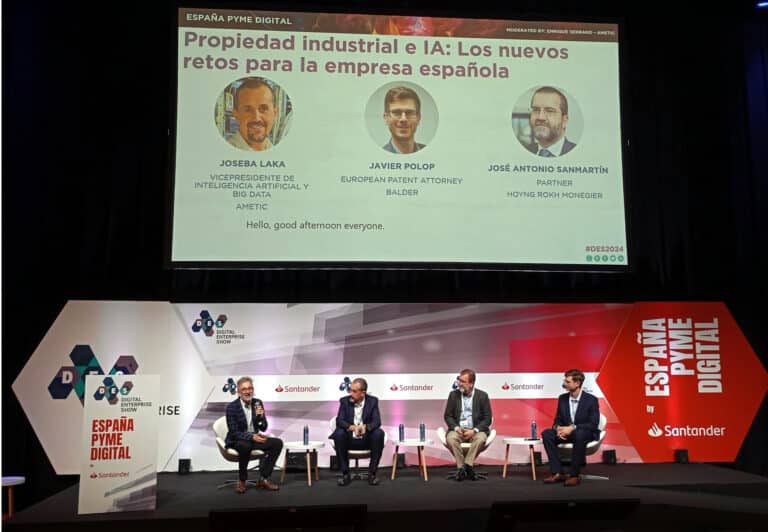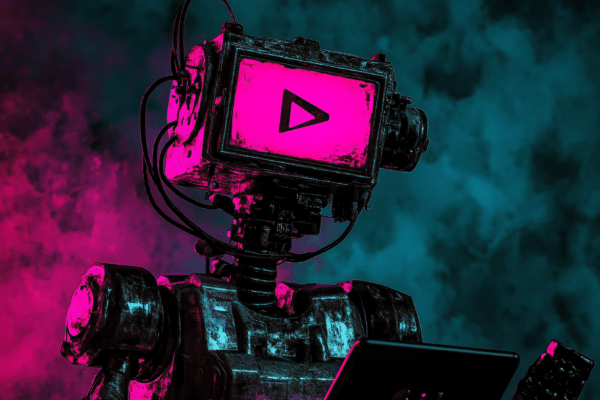The arrival of generative artificial intelligence in the realm of intellectual and industrial property has raised numerous questions, such as: If an AI is responsible for creating a patent, does the invention belong to the AI, the creator of the AI, or should it be public domain? What degree of human intervention is necessary for it to be attributed to a person? Should inventions generated by AI receive the same protection as those created by humans? And under what criteria?
These and other issues were addressed in a panel held a few days ago at DES 2024, the congress on digitalization and artificial intelligence that took place in Malaga. The round table featured Joseba Laka, Vice President of Artificial Intelligence and Big Data at AMETIC, Javier Polop, European Patent Attorney at Balder, and José Antonio Sanmartín, Partner at the intellectual and industrial property firm Hoyng Rokh Monegier.
Laka explained how they published a document of recommendations related to regulatory changes last year. He also highlighted the discrepancies between different countries in the European Union regarding the AI Act, the European artificial intelligence regulation that addresses many of these aspects. For example, he mentioned that France has its reservations. "We must act together, not as individual companies. A law can generate significant change. The Patent Law of 1952 treated things not as a flash but as a systematic investment process. Companies need certainty to know where the perimeter of possible protection lies," stated the AMETIC representative.
For the partner at Hoyng Rokh Monegier, it is essential to recognize that "AI represents a paradigm shift in copyright," since "technological processes have never before posed authorship problems." From the authorship perspective, two types of inventions would be distinguished: one where AI is a tool, and the problem is identified by a human, the inventor, and the other where AI detects a problem and offers a solution.
Sanmartín mentioned how Microsoft was not the author when you used Word to write a text or create a document. But with generative AI, things could change. "We need to see how to protect that creativity. Now we have systems that involve human intervention, even if minimal. AI will never be granted full authorship. But some countries, such as the UK, India, and Japan, do recognize some authorship to AI. In the rest of the legislations, they still talk about human authors," he clarified.
In Sanmartín's opinion, to obtain protection, it is necessary to make clear that some human intervention has been required. Additionally, he argues that writing a prompt would not be enough to consider it human intervention. "A prompt would be equivalent to the instructions a patron would give an artist, but the AI makes the brushstroke. That is why intellectual property of those works is not admitted," he emphasized.
"Finally, it should be noted that in China, prompts are recognized as indicating certain creative decisions," clarified the representative of Hoyng Rokh Monegier. Sanmartín advocated for incentivizing the technological aspect "in some way" and not prohibiting the use of artificial intelligence.
European patent agent Javier Polop believes that the issue of having a physical person could change in the future. "Artificial intelligence has a fundamental importance in industrial research. A patent provides very powerful protection. Today, the principles are well accepted," he stated.
Polop explained how applying for a European patent involves a more rigorous process than for a Spanish patent. Article 52(1) of the European Patent Convention (EPC) establishes that patents will be granted for inventions in technological fields, provided they are new, involve an inventive step, and are susceptible of industrial application. Within these three requirements, explaining the technical effect is very important, as it forms the basis of the inventive step. If this cannot be clarified, "the examiner does not grant the patent," commented the Balder representative. For Laka, having to review these technical aspects thoroughly explains why there are so few artificial intelligence patents. "We are far from being efficient," in this aspect, he added.
In any case, Polop mentioned that there are 100 times more patent applications in artificial intelligence in Europe than in Spain. He also acknowledged that in certain industries, such as the automotive industry, "it is worrying that the creative part comes from AI."
Sanmartín mentioned a case where a programmer had intervened in the final retouching of a work, but in the United States, that was not considered sufficient to grant authorship of the work. "In China, they are somewhat more lenient with these things," he said. "It is a very difficult balance." "If we talk about you executing the work and the AI finishing it, or making the drawing and the AI coloring it, it could be considered as a tool, and here it would be more feasible to grant it," he concluded.
Clarifying What is Patentable and What is Not
A report published by the European Commission titled "Trends and Developments in Artificial Intelligence: Challenges to the Intellectual Property Rights Framework" and referenced by the Ministry of Industry, Commerce, and Tourism discusses various factors that come into play for patentability. These include patentable subject matter, the right to invention in AI-generated inventions, prior art generated by AI, the assessment of inventive step (person skilled in the art), sufficiency of disclosure, and liability in patent infringement by AI. "AI is based on computational models and algorithms such as neural networks, genetic algorithms, machine learning, etc. By themselves, they are abstract in nature, lack technical character, and cannot be patented," the text states.
However, it does cite some AI-involved inventions that have the mentioned technical character and can be patented. For example, "the use of an artificial neural network in a heart monitoring apparatus to detect irregular heartbeats, as it produces a technical contribution." These aspects are outlined in the 2020 webinar of the Spanish Patent and Trademark Office. Although ChatGPT and generative AI had not yet been democratized, these considerations are still valid today as the requirements remain unchanged.
Moreover, the document discusses how numerous companies use AI as a tool for inventing, such as in the pharmaceutical industry. Here, artificial intelligence is used for identifying new compounds that could be new patentable drugs, predicting how these potential compounds will behave in trials, analyzing possible combinations of existing drugs that could act synergistically, finding new uses for existing drugs, or creating personalized medicine based on genetic markers.
Currently, experts are still debating between two opinions. There are those who believe we are still far from AI autonomously generating inventions and, therefore, do not think patent law modifications are necessary. On the other hand, there is a group of experts who argue for the need to modify patent law, as they find that AI-generated inventions are already being created and patented.






